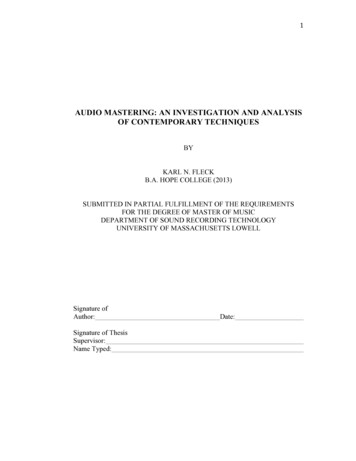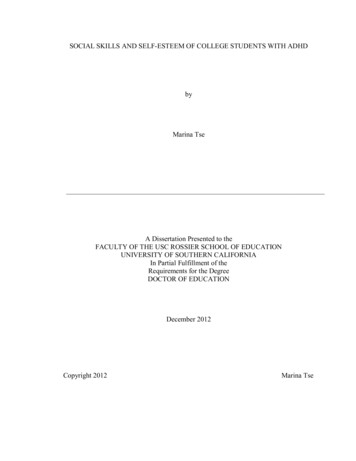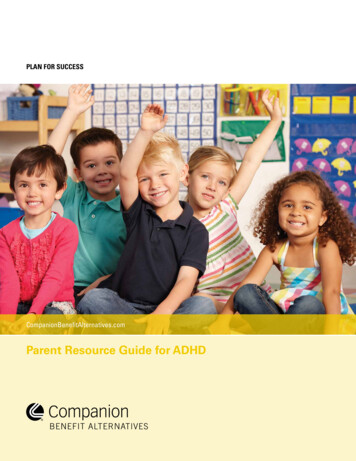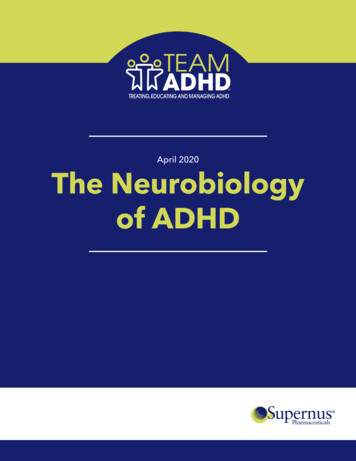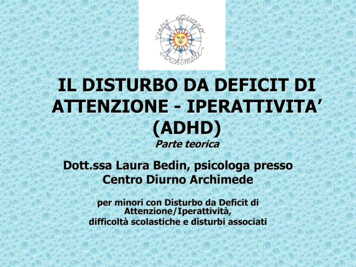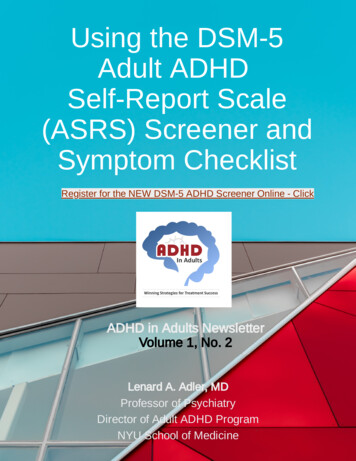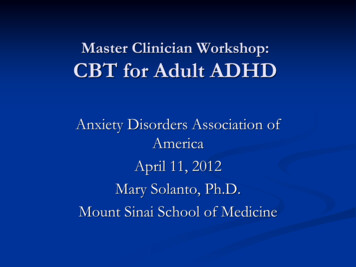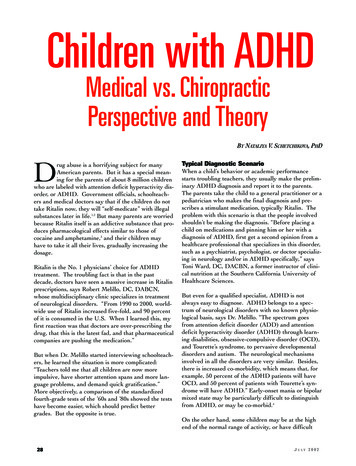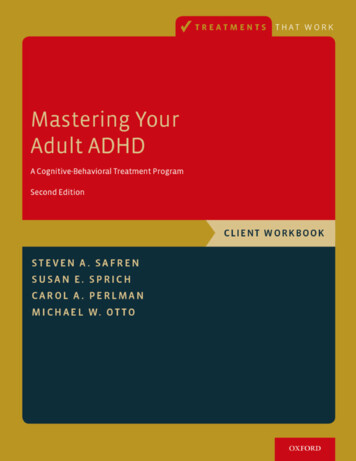
Transcription
Mastering Your Adult ADHD
T R E AT M E N T S TH AT WORKEditor- In- ChiefDavid H. Barlow, PhDScientific Advisory BoardAnne Marie Albano, PhDGillian Butler, PhDDavid M. Clark, PhDEdna B. Foa, PhDPaul J. Frick, PhDJack M. Gorman, MDKirk Heilbrun, PhDRobert J. McMahon, PhDPeter E. Nathan, PhDChristine Maguth Nezu, PhDMatthew K. Nock, PhDPaul Salkovskis, PhDBonnie Spring, PhDGail Steketee, PhDJohn R. Weisz, PhDG. Terence Wilson, PhD
T R E AT M E N T S T H AT W O R KMastering YourAdult ADHDA Cognitive- Behavioral Treatment ProgramSecond EditionCLIENT WORKBOOKSTEVEN A. SAFRENSUSAN E. SPRICHCAROL A. PERLMANM I C H A E L W. O T T O1
1Oxford University Press is a department of the University of Oxford. It furthersthe University’s objective of excellence in research, scholarship, and educationby publishing worldwide. Oxford is a registered trade mark of Oxford UniversityPress in the UK and certain other countries.Published in the United States of America by Oxford University Press198 Madison Avenue, New York, NY 10016, United States of America. Oxford University Press 2017First Edition published in 2005Second Edition published in 2017All rights reserved. No part of this publication may be reproduced, stored ina retrieval system, or transmitted, in any form or by any means, without theprior permission in writing of Oxford University Press, or as expressly permittedby law, by license, or under terms agreed with the appropriate reproductionrights organization. Inquiries concerning reproduction outside the scope of theabove should be sent to the Rights Department, Oxford University Press, at theaddress above.You must not circulate this work in any other formand you must impose this same condition on any acquirer.ISBN 978– 0– 19– 023556– 79 8 7 6 5 4 3 2 1Printed by WebCom, Inc., Canada
AboutT R E AT M E N T S T H AT W O R KOne of the most difficult problems confronting patients with various disorders and diseases is finding the best help available. Everyone is aware offriends or family who have sought treatment from a seemingly reputablepractitioner, only to find out later from another doctor that the originaldiagnosis was wrong or the treatments recommended were inappropriateor perhaps even harmful. Most patients, or family members, address thisproblem by reading everything they can about their symptoms, seeking out information on the Internet or aggressively “asking around” totap knowledge from friends and acquaintances. Governments and healthcare policymakers are also aware that people in need do not always getthe best treatments—something they refer to as variability in healthcare practices.Now health care systems around the world are attempting to correct thisvariability by introducing evidence-based practice. This simply means thatit is in everyone’s interest that patients get the most up-to-date and effective care for a particular problem. Health care policymakers have alsorecognized that it is very useful to give consumers of health care as muchinformation as possible, so that they can make intelligent decisions in acollaborative effort to improve physical health and mental health. Thisseries, Treatments That Work, is designed to accomplish just that. Onlythe latest and most effective interventions for particular problems aredescribed in user-friendly language. To be included in this series, eachtreatment program must pass the highest standards of evidence available,as determined by a scientific advisory board. Thus, when individuals suffering from these problems or their family members seek out an expertclinician who is familiar with these interventions and decides that they areappropriate, patients will have confidence they are receiving the best careavailable. Of course, only your health care professional can decide on theright mix of treatments for you.This particular program presents the first evidence-based psychological treatment for adult attention-deficit/hyperactivity disorder (adultADHD). In this program, you will learn skills that directly attack thev
symptoms that make living with adult ADHD so difficult. These symptoms include difficulty focusing attention and being easily distracted, difficulties with organization and planning, and impulsivity. This programcan be effectively combined with medications, or for individuals whoderive relatively little benefit from medications, this program may be sufficient on its own. This fully updated second edition of the Workbookcontains worksheets, forms, and online resources to help you duringtreatment and is most effectively applied by working in collaborationwith your clinician.David H. Barlow, Editor- in- Chief,Treatments ThatWorkBoston, MAReferencesBarlow, D. H. (2004). Psychological treatments. American Psychologist, 59, 869– 878.Barlow, D. H. (2010). Negative effects from psychological treatments: A perspective. AmericanPsychologist, 65(2), 13–20.Institute of Medicine. (2001). Crossing the quality chasm: A new health system for the 21st century.Washington, DC: National Academy Press.McHugh, R. K. & Barlow, D. H. (2010). Dissemination and implementation of evidence-basedpsychological interventions: A review of current efforts. American Psychologist, 65(2), 73–84.vi
Accessing Treatments ThatWork Forms and Worksheets OnlineAll forms and worksheets from books in the TTW series are made available digitally shortly following print publication. You may download, print, save, and digitally complete them as PDF’s.To access the forms and worksheets, please visit http://www.oup.com/us/ttw.vii
ContentsModule 1Module 2Module 3Chapter 1Information About Adult ADHD1Chapter 2Overview of This Treatment Program for ADHDin Adulthood 9Chapter 3Informational Session with Spouse, Partner, or FamilyMember (if applicable) 17Organizing and PlanningChapter 4The Foundation: Organizing and Planning Skills 23Chapter 5Organization of Multiple Tasks 31Chapter 6Problem Solving and ManagingOverwhelming Tasks 39Chapter 7Organizational Systems 45Reducing DistractibilityChapter 8Gauging Your Attention Span andDistractibility Delay 53Chapter 9Modifying Your Environment 61Adaptive ThinkingChapter 10Introducing a Cognitive Model of ADHD 69Chapter 11Adaptive ThinkingChapter 12Rehearsal and Review of Adaptive Thinking Skills 9383ix
Module 4Additional SkillsChapter 13Application of Skills to Procrastination (optional) 99Chapter 14Handling SlipsAppendixForms and WorksheetsReferences 125About the Authorsx127107111
Mastering Your Adult ADHD
CHAPTER 1Information About Adult ADHDOVERVIEWThis chapter will provide you with information about ADHD in adulthood, how ADHD is diagnosed in adults, and an orientation to thecognitive- behavioral model of ADHD. This information will help youdecide if this treatment program is right for you.GOALS To understand the characteristics of ADHD in adulthoodTo learn why ADHD symptoms continue in adults even aftertreatment with medicationsTo understand that ADHD is a valid diagnosis for adultsWhat Is ADHD?Attention- deficit/ hyperactivity disorder (ADHD) is a valid, medical, psychiatric disorder. ADHD begins in childhood, and many children withADHD go on to have significant symptoms as adults. As shown in Figure 1.1,there are three major types of symptoms people have: poor attention,hyperactivity, and impulsivity.The term disinhibition (lack of inhibition) is also sometimes used todescribe the impulsivity and hyperactivity symptoms. Many people withADHD have at least some symptoms of poor attention, some symptoms1
SYMPTOMS OF POOR ATTENTIONDistracted easilyDifficulty organizingEasily boredSwitch from one task to anotherDifficulty planningDifficulty concentratingCan’t do boring or unattractive tasksSYMPTOMS OF HYPERACTIVITYFeel like driven by a motorRestlessCan’t sit stillAlways on the goFidgetySYMPTOMS OF IMPULSIVITYInterrupt oftenAnswer questions before person finishesaskingBlurt out inappropriate commentsAct before thinkingDo things you later regretDifficulty waitingFigure 1.1Symptoms of poor attention, hyperactivity, and impulsivityof hyperactivity, and some symptoms of impulsivity, although many people have symptoms that are predominately from one category. The termattention deficit disorder (ADD) is also sometimes used when an individual has the attentional symptoms but not the hyperactivity symptoms.ADHD Is Not Related to Intelligence or LazinessPatients with ADHD can learn coping skills to manage associated difficulties. Kate Kelly and Peggy Ramundo have written a self- help bookfor adults with ADHD called You Mean I’m Not Lazy, Stupid, or Crazy?(1993). This title underscores many of the common misperceptions thatpeople with ADHD have about themselves.ADHD is a neurobiological disorder, unrelated to intelligence, laziness,aptitude, being or not being crazy, and so on. This treatment program,which typically begins after an individual has been taking ADHD medications for several months, can help control the symptoms of ADHD foradults. By actively learning skills and practicing them regularly, you willsee significant improvements.2
What Are the Specific Criteria for a Diagnosis of ADHD?Generally, a diagnosis of ADHD is made by a mental health professional,using the definition set forth in the American Psychiatric Association(APA)’s Diagnostic and Statistical Manual of Mental Disorders, 5th edition(DSM- 5; 2013). The DSM- 5 lists all of the various psychiatric disordersand the symptoms and other requirements that an individual must display to be diagnosed with them.To meet the DSM- 5 criteria for adult ADHD, individuals must have atleast five out of the nine possible inattention symptoms and/ or five outof the nine possible symptoms of hyperactivity/ impulsivity. Individualswho have five or more symptoms in only the inattention category haveADHD, predominantly inattentive presentation. Those who have five ormore symptoms in the hyperactivity/ impulsivity category have ADHD,predominantly hyperactive/ impulsive presentation. And those with five ormore symptoms in both categories have ADHD, combined presentation.Inattentive symptoms include such things as failing to give close attention todetails, difficulty sustaining attention in tasks, seeming not to listen whenbeing spoken to directly, failure to follow through on instructions, difficulties with organization, avoidance of tasks that require sustained mentaleffort, frequently losing things, getting distracted easily, and being forgetful.Hyperactive/ impulsive symptoms include fidgeting, leaving one’s seat frequently, feelings of restlessness, being unable to engage in quiet activities,being “on the go,” talking excessively, blurting out answers, having difficulty waiting in lines, and frequently interrupting.In addition, (1) the person needs to have had at least some of the symptoms before the age of 12, (2) the symptoms need to be present in at leasttwo different settings, (3) the symptoms need to clearly interfere with theindividual’s ability to function, and (4) it must be clear that the symptomsare not better accounted for by a different mental disorder (APA, 2013).How Do We Distinguish ADHD as a Diagnosis from Normal Functioning?Some of the symptoms listed above sound like they might apply to almostanyone at certain times. For example, most people would probably say thatthey are sometimes easily distracted or sometimes have problems organizing. This is actually the case with many of the psychiatric disorders. Forexample, everyone gets sad sometimes, but not everyone meets criteria for3
a clinical diagnosis of depression. To qualify for a diagnosis of ADHD, theperson must have significant difficulties with some aspect of his or her life,such as work, school, or relationships. In DSM- 5, there is more attentionto impairment specific to adults, such as impairment in work situations.Also, to qualify for the diagnosis, the person’s distress and impairmentmust be caused by ADHD and not by another disorder. A thoroughassessment is needed to rule out the possibility that the symptoms reflectanother psychiatric disorder.How Do Cognitive and Behavioral Variables Make ADHD Worse for Adults?Cognitive components (thoughts and beliefs) can worsen ADHD symptoms. For example, a person who is facing something that he will findoverwhelming might shift his attention elsewhere, or think things like,“I can’t do this,” “I don’t want to do this,” or “I will do this later.” Behavioralcomponents are the things people do that can make ADHD symptomsworse. The actual behaviors can include things like avoiding doing whatyou should be doing or keeping or not keeping an organizational system.Later in this chapter, we show a model of how we believe ADHD affectsthe lives of adults. According to this model, the core symptoms of ADHDare biologically based. However, we believe that cognitive and behavioralvariables also affect symptom levels.Core neuropsychiatric impairments, starting in childhood, prevent effectivecoping. By definition, adults with ADHD have been suffering from this disorder chronically since childhood. Specific symptoms such as distractibility,disorganization, difficulty following through on tasks, and impulsivity canprevent people with ADHD from learning or using effective coping skills.Because of these symptoms, individuals with this disorder typically havesustained underachievement, or other experiences that they might label as“failures.” In turn, this history of failures can result in people with ADHDdeveloping overly negative beliefs about themselves, as well as negative,maladaptive thinking when approaching tasks. The negative thoughtsand beliefs that ensue can therefore add to avoidance or distractibility.Therefore, people with ADHD shift their attention even more when confronted with tasks or problems that they may find difficult or boring, andrelated behavioral symptoms can also get worse.A model of how these factors interrelate is presented in Figure 1.2.4
Core(Neuropsychiatric)Impairments inHistory ofFailureUnderachievementRelationship problemsNegative thoughts andbeliefs (e.g., negativeself-statements, ngerFailure to UtilizeCompensatory Strategies– examples:OrganizingPlanning (i.e., tibilityFunctionalImpairmentFigure 1.2Cognitive- behavioral model of adult ADHDReprinted from S. A. Safren, S. Sprich, S. Chulvick, & M. W. Otto (2004). Psychosocial treatments for adults with ADHD. Psychiatric Clinicsof North America, 27(2), 349– 360, 2004 Elsevier Inc., with permission from Elsevier.Don’t Medications Effectively Treat ADHD?Yes. Medications are currently the first- line treatment approach for adultADHD, and they are the most extensively studied. The classes of thesemedications are stimulants, tricyclic antidepressants, monoamine oxidase inhibitors (antidepressants), and atypical antidepressants. However,a good number of individuals (approximately 20% to 50%) who takeantidepressants are considered nonresponders. A nonresponder is an individual whose symptoms are not sufficiently reduced, or someone whocannot tolerate the medications. Additionally, adults who are consideredresponders typically show a reduction in only 50% or less of the coresymptoms of ADHD.Because of these data, recommendations for the best treatment ofadult ADHD include using psychotherapy (cognitive- behavioral therapy in particular) with medications. Medications can reduce many ofthe core symptoms of ADHD: attentional problems, high activity, andimpulsivity.5
You may be asking yourself why this treatment program is needed inaddition to medications. The answer is that medications alone cannotprovide adults with ADHD with concrete strategies and skills for coping.Furthermore, disruptions resulting from ADHD, such as underachievement, unemployment or underemployment, economic problems, andrelationship difficulties, call for additional interventions to improve theperson’s quality of life.ADHD in Adulthood Is a Real and Valid Medical ConditionWe are including this section here in this client workbook because inthe recent past, ADHD was a controversial diagnosis. However, the pastseveral decades of study have shown that its validity is now strong. Herewe will describe the controversy regarding the diagnosis and outline theevidence that has led experts to conclude that adult ADHD is a prevalent,distressing, impairing, and valid medical diagnosis.Psychiatric and Psychological Diagnoses Are Difficult to ValidateCompared to Other Biomedical DiseasesADHD in adulthood is a real, reliably diagnosed medical illness thatmay affect up to 5% of the adults in the United States. ADHD inadulthood has historically been a controversial diagnosis. One of thereasons for this is that psychiatric diagnoses, in general, are difficult tovalidate. In many other medical fields, doctors can perform a bloodtest, do an x- ray, take a biopsy, or even take a patient’s temperature tohelp make a diagnosis. In these cases, overt medical evidence complements the report of the patient. However, for psychiatric disorders, thisis impossible at present. Doctors must diagnose psychiatric disordersbased only on their patient’s self- report of their symptoms, their ownobservation of the patient, or the observations of others. Therefore,psychiatrists and psychologists have developed a way to categorize psychiatric disorders that involves looking at groups of symptoms thatpeople have.How Do Doctors Validate Psychological or Psychiatric Diagnoses?To validate a psychiatric or psychological diagnosis, psychologists andpsychiatrists examine data such as the degree to which trained individuals6
agree on the diagnosis, the degree to which the disorder runs in families(including adoption studies to determine the relative impact of biologyvs. environment), any neuroimaging and neurochemistry studies, and thedegree to which people who have the problem experience distress. Thishas been done sufficiently for adult ADHD.How Do We Know That ADHD Is a “Real” Diagnosis?Sufficient scientific evidence has accumulated over the past severaldecades leading toward the finding that ADHD is a real, significant,distressing, interfering, and legitimate medical problem. This includesevidence that ADHD can be reliably diagnosed in adults and that thediagnosis meets standards of diagnostic validity similar to those ofother psychiatric diagnoses. Accordingly, core symptoms in adulthoodinclude impairments in attention, inhibition, and self- regulation.These core symptoms lead to impairments in adulthood, such as thefollowing: Poor school and work performance (e.g., difficulty with organizationor planning, becoming easily bored, deficient sustained attention toreading and paperwork, procrastination, poor time management,impulsive decision making)Impaired interpersonal skills (e.g., problems with friendships, poorfollow- through on commitments, poor listening skills, difficultywith intimate relationships)Behavior problems (e.g., individuals with ADHD are less educatedthan predicted based on ability, difficulties with financialmanagement, trouble organizing one’s home, chaotic routines)There is further evidence for the validity of ADHD as a diagnosis frommedication treatment studies, genetic studies that include adoption andfamily studies, and neuroimaging and neurochemistry research.Children with ADHD Do Grow UpIt is estimated that between 1% and 5% of adults have ADHD. This isconsistent with estimates that ADHD affects 2% to 9% of school- agechildren, and follow- up studies of children diagnosed with ADHD showthat impairing ADHD symptoms persist into adulthood (beyond adolescence) in 30% to 80% of diagnosed children.7
ConclusionNow that you have learned about adult ADHD and this treatment program, you are ready to begin! You have already taken a big step by purchasing this workbook and making the decision to participate in thisprogram. Let’s get started!8
CHAPTER 2Overview of This TreatmentProgram for ADHD in AdulthoodOVERVIEWThis chapter will provide information about how this program wasdeveloped to address the specific concerns of adults with ADHD whoare treated with medications. The chapter will also provide informationabout the success of the program in addressing these concerns and additional information about exactly what the program will entail.GOALS To learn how this program was developedTo learn about the concerns of medication- treated adultswith ADHDTo understand the success rate of the program so farTo understand what the program will involveThis treatment program is meant to be completed with the assistanceof a cognitive- behavioral therapist. The treatment was developed by theMassachusetts General Hospital’s Cognitive- Behavioral Therapy Program.It was based on the clinical experience of the authors, input from adultswith ADHD, and published works on treatment for adults with ADHD(e.g., Barkley, 1998; Hallowell, 1995; Mayes, 1998; McDermott, 2000;Nadeau, 1995). It is designed for individuals who have been diagnosed9
with ADHD, have been on medications for ADHD, and have found astable medication regimen. The strategies may be useful for adults withADHD who cannot take medications, but we have only tested it for individuals who were already taking medications.How Was the Program Developed?Clinical Experience of the AuthorsThe program was developed by a group of psychologists at MassachusettsGeneral Hospital and Harvard Medical School after treating patients withADHD in our clinic using cognitive- behavioral therapy. From this perspective, it was originally developed based on our clinical experience, thegeneral principles of cognitive- behavioral therapy, and published clinicalguidelines for working with adult patients with ADHD.Input from Adults with ADHDPatients with ADHD also gave input to the development of the treatment program. One of us interviewed a group of patients with ADHDwho had been taking medications about the types of problems they wereexperiencing and what they felt would be helpful regarding cognitive- behavioral treatment.The most frequently discussed problems among adult patients withADHD who had been taking medicines were (1) organizing and planning, (2) distractibility, and (3) associated anxiety and depression. Otherconcerns included problems with procrastination, anger management,and communication issues.Organizing and PlanningProblems with organizing and planning involve difficulties figuring outthe logical, discrete steps to complete tasks that seem overwhelming.For many clients, this difficulty leads to giving up, procrastination,anxiety, and feelings of incompetence and underachievement. Forexample, several of our clients who were underemployed or unemployed had never completed thorough job searches, so they did not havea job, were working in much lower- paying positions than they couldhave been, or were not working at a job that would lead to appropriateemployment.10
DistractibilityThe problems with distractibility involved problems in work or school.Many of our clients have reported that they do not complete tasks becauseother, less important things get in the way. Examples might include sitting down at one’s computer to work on a project, but constantly goingon the Internet to look up certain websites or browsing social networkingsites. One student in our program told us that whenever he sat down towork on his thesis, he would find another place in his apartment to clean(even though it was already basically clean enough).Mood Problems (Associated Anxiety and Depression)Secondary to core ADHD symptoms, many of our clients have moodproblems. These problems involve worry about events in their lives, andsadness regarding either real or perceived underachievement. Many individuals with ADHD report a strong sense of frustration about tasks thatthey do not finish, or do not do as well as they feel that they could have.Has This Program Been Successful?Yes! In our study of this treatment, we found that people who completedthis program in addition to taking their medications did significantly better than people who stayed on their medications but did not receive thistreatment (Safren, Otto, Sprich, Winett, Wilens, & Biederman, 2005).We conducted a “randomized controlled trial” to find these results.Randomized controlled trials are a primary way researchers test whethertreatments work. They are called randomized because patients enteringthe study randomly receive either the treatment or a control condition. Inour study we only took in patients with ADHD who were being treatedwith medications and still had significant problems. These patients wererandomized to either getting the treatment described in this book orno additional treatment. (All patients continued taking their prescribedmedications.)In this study, the people who got the treatment had significantly lowersymptoms of ADHD after the treatment. This was evaluated by anindependent assessor who did not know whether the participants gotthe treatment or not, and by the self- report of participants who completed written questionnaires about their symptoms. According to these11
assessments, patients who went through the program experienced abouta 50% decrease in symptoms, and those who did not had negligiblechanges.Later, we conducted a larger five- year study funded by a grant from theNational Institute of Mental Health (to Dr. Safren), also using the firstversion of our treatment manual. This study involved comparing thetreatment in this manual plus continued medications to a comparisontreatment (relaxation plus educational support) plus continued medications (Safren, Sprich, Mimiaga, Surman, Knouse, Groves, & Otto, 2010).Eighty- six adults with ADHD participated in this study. We found thatparticipants receiving cognitive- behavioral treatment achieved lowerscores on measures of ADHD compared with participants receiving thecomparison treatment, and there were more responders in the cognitive- behavioral treatment group than the comparison group. This means thatmore people in the cognitive- behavioral treatment group were consideredsignificantly improved than in the comparison group. These gains weremaintained at six- and 12- month follow- up.What Will the Program Entail?Regular Meetings with a Therapist and Home PracticeThe treatment involves regular meetings with a cognitive- behavioral therapist and home practice assignments. We have found that weekly sessionswork best. By having weekly sessions, you have a chance to practice theskills discussed in the treatment every week. Also, there is a relatively shortperiod of time between sessions so that any problems with follow- throughcan be solved, and any questions about the approach can be answered.When we have conducted sessions every other week, clients reported thatit was difficult because they would forget what they were supposed to bedoing on their own.The treatment is different than traditional psychotherapy. In fact, in someways it is more like taking a course than being in supportive psychotherapy. Each session will have an agenda, and each session will have an associated home practice assignment.12
Practice Is EssentialThe program involves practicing outside of the sessions: There are no twoways about it! We have found that many clients have tried similar strategies in the past but have had difficulties integrating this practice into theirdaily lives. In other words, the tendency to be distractible and forgetfulcan get in the way of treatment. We will work with you to “set in” newhabits that you can keep with you over the yearsYou will need to practice these new skills long enough for them tobecome a habit— for them to be easy to use and remember.Do Not QuitYou may be tempted to quit, but not at the beginning when things willbe exciting and new and therefore more interesting. People typically donot quit at the beginning. The middle period can sometimes be the hardest. This is when the novelty wears off, but people have not practiced theskills long enough for them to become habits. Many people show someimprovement at the beginning, enough so they start to think that they donot need to use the skills. In this case, people may quit (because it is nolonger new and interesting, and is not yet an easy habit), but then theyrelapse back to having problems, and then think, “I tried to change andI could not do it.” Hence, the cycle of negative emotions and continuedADHD symptoms persists.Do not succumb to this temptation!This may be the hardest part of the treatment program. The key to gettingbetter is to stay on track and stick with the program long enough for it tobecome easier. There will be ups and downs over the course of treatment.But when there is a “down,” this is definitely not the time to quit. Rather,this is the time to learn from the things that led up to the setback, andfigure out how to handle them in the future. This is extremely important.Setbacks are a major part of progress. You need to have setbacksand learn to handle them in order to reduce the likelihood offuture setbacks!13
The final period is likely to be easier, but it can also entail challenges. Onceyou start seeing improvements, you will be faced with the challenge ofcontinuing to invest some time and energy in maintaining these systemsand skills even though things are going better. We have found that somepeople, once they are doing better, feel less motivated to keep using thecoping skills. If things are bad, then there is more motivation because people feel that the need to “get out of the hole.” But when things are goingwell, some people lose their motivation— and this can lead to setbacks.The Three Modules of the ProgramOrganization and PlanningThe first part of the treatment involves organization and planning skills.This includes skills such as the follo
Mastering Your Adult ADHD A Cognitive-Behavioral Treatment Program Second Edition Oxford University Press is a department of the University of Oxford. It furthers the University’s objective of excellence in research, scholarship, and education by publishing worldwid

